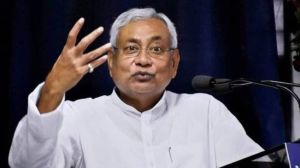The great mental wall
Made in China may be a notorious tag for products to have across India and chowmein and gobi manchurian...

Made in China may be a notorious tag for products to have across India and chowmein and gobi manchurian may have overtaken the humble dal-chawal or masala vada in popularity in some parts of the country, but across the Bamboo Curtain, Beijing’s neighbour and the world’s second most populous nation is struggling to register its presence in similar fashion in the popular imagination.
Even as New Delhi is getting its knickers twisted over protecting the Olympic torch relay and assorted celebrities are hoisting a symbolic red flag against the event, India’s trials and tribulations have hardly created a ripple in the state-controlled Chinese consciousness that seems to inhabit a different zone.
Sample this for disconnect. “When we were young, we saw a lot of Indian films,” said Zhang Fong, a middle-aged Chinese woman who sells mementos at the Great Wall. “I think Indians are very happy people, they are always dancing and singing.”
Last week, at the height of the torch controversy and the launch of a tourism campaign in Beijing and Shanghai to promote India, one of the few reports from India that made it to China Daily, a leading English newspaper, was how a two-headed baby in Bihar was doing well.
India, strategic affairs experts often say, does not figure too much on the radars of the Chinese establishment. For ordinary Chinese, India seems like a no-fly zone few among the 1.3 billion people have dared breach. A disputed Himalayan border, political and diplomatic paranoia developed after the arrival of the Dalai Lama in India and the 1962 war, cultural barriers and a conscious decision by Beijing to look West has meant that two ancient civilisations with strong links have drifted apart.
As the neighbours now try to rediscover each other on the back of soaring business ties, and attempts to foster the diplomatically cliched but nevertheless crucial “people-to-people” relations, the challenges seem daunting.
“For the last 100 years or so, China has been very focused on the West,” says Qiu Yonghui, a professor studying Hinduism at the Chinese Academy of Social Sciences. “Now, because of the Internet and mobile phones, they are becoming aware that they can learn a lot from India. But for that to happen, India needs to open up more to the Chinese,” she said.
Some Indian diplomats and China-watchers admit that a traditional sense of negativism and suspicion about Beijing has developed into a vicious cycle that feeds on itself and hampers making bold moves unlike the autocratic system in Beijing that faces no such qualms.
But there is more to this disconnect than a handful of officials and politicians in South Block though. While India has a shared culture with its South Asian neighbours and even some South-East Asian countries, the “soft power” of Indian culture has been successfully exported to regions like the Middle East, Britain and North America by the large immigrant populations, in turn helping boost bilateral relations.
In contrast, only about 25,000 Indians live in China today while more than 100 Indian companies—including large firms like Reliance, TCS, L&T, Infosys and Essar—and nine Indian banks have a presence in China.
But a restrictive Chinese government, which closely controls what its people see and hear, places barriers in the path of free flow of information. And the relatively small size of the Indian community does not allow informal or even illegal avenues for profitable trade in popular music and cinema.
Lobbying the Chinese government is a sureshot method to ensure the success of campaigns such as “Incredible India” which the Tourism Ministry launched in Beijing and Shanghai last week, says Prakash Menon, president of NIIT China. “The Chinese have a mindset which follows government diktats. If the government promotes Thailand one year, all Chinese foreign tourists go to Thailand. So we should infiltrate the Chinese ministry and get them to do a ‘Go India Year’.”
Nevertheless, small cracks are beginning to appear in the wall that separates India and China due to the trickle of people crossing each other’s borders, experts said.
For a country that is so obsessed with economic progress and success, the rise of Bangalore as a software power has brought new respectability to India, says Menon.
Zee Telefilms has exported two of its popular soaps—Karishma and Koshish ek Asha—which have been dubbed into Chinese. Aishwarya Rai screensavers and desktop wallpapers are beginning to make their appearances and the odd Bollywood theme nights are drawing Chinese enthusiasts.
Although the 60-plus Indian restaurants across China cater largely to expat Indians or visitors to the country, locals have also begun to develop a taste for Indian cuisine, says Imran Siddiqui, manager of the popular ‘Tandoor’ in Shanghai. So biryani is slowly gaining ground as chow fan or Indian fried rice, roomali roti as fei ping or flying bread and chicken curry as cully chi.
The onus of tapping this latent interest lies largely with the Indian establishment, says Prof Qiu. “It is not as if the Chinese don’t want to go to India or know more about India. It is just tougher to go. Sometimes they give business visas for three months and expect people to come back to renew them. How can India ask people to come to India and then close its doors? Sometimes, I feel India is a very open society with a very closed mind.”





- 01
- 02
- 03
- 04
- 05


























